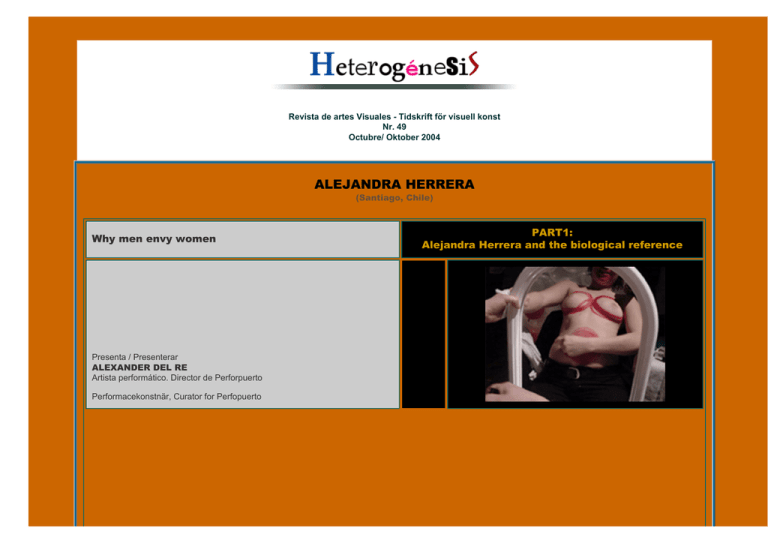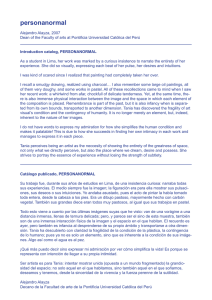Descargar texto - Alexander Del Re
Anuncio

Revista de artes Visuales - Tidskrift för visuell konst Nr. 49 Octubre/ Oktober 2004 ALEJANDRA HERRERA (Santiago, Chile) Why men envy women Presenta / Presenterar ALEXANDER DEL RE Artista performático. Director de Perforpuerto Performacekonstnär, Curator for Perfopuerto PART1: Alejandra Herrera and the biological reference Alejandra Herrera (nacida en 1975) es una jóven artista chilena cuyos principales medios son la fotografía digital, el performance y la instalación. Sus exploraciones sobre su propio cuerpo hacen constante referencia a las inevitables implicaciones biológicas de ella misma en tanto mujer, y en tanto ser social. En 2002, en su performance ”La dieta” analiza el proceso de construcción y deconstrucción de un cuerpo femenino a tavés de una perfección impuesta, implícita en la búsqueda de la belleza. También está interesada en su relación (espacial) con los demás. En su performance ”Coalition” , de 2003, ella explora su ser social como objeto de deseo voyeurístico; ella solicitó a los asistentes que incorporasen sus huellas digitales a un tejido que luego se convirtió en su atuendo. Su vestido es cosido por su asistente, al tiempo que los asistentes som llamados a comunicarse con ella – con los ojos vendados – por medio de un aparato sonoro. En sus instalaciones recientes, ella explora provocativamente la conección entre el espacio metafórico femenino. (el huevo) y el espacio social de la ciudad portuaria en la que vive (un barco hundido de juguete en una pecera); se supone que la audiencia debe tomar posición con respecto al espacio de la instalación por medio del sonido que producen al caminar sobre la superficie de plástico que cubre el piso de la galería. El cuerpo femenino de la artista está en constante circulación entre el espacio interior y el espacio social, del ser biológico a la referencia dinámica que encarna. Alejandra Herrera (born 1975) is a chilean young artist whose main media are digital photography, performance and installation art. Her exploration in her own body provides a constant reference to the inevitable biological implications of herself as a woman, as well as a social being. In her performance “La dieta” (“the diet”), she analizes the process of construction and deconstruction of a female body through the imposed perfection, implicit in the pursue of beauty. She is also interested in her (spatial) relation with the others, in her performance for “Coalition” from 2003, she explores her social being as an object of voyeuristic desire; she requested the audience to incorporate their fingerprints into a fabric, which then becomes her outfit. Her dress is sewn by an assistant, as the audience is encouraged to communicate with her, eye covered, by means of an audio device. In her recent installations, she provokes the connection between the metaphoric female space (the egg) and the social space from the port city where she lives (a toy ship wreck in a fish bowl); the audience is meant to relate to the installation space through the sound they produce by walking on the plastic surface covering the gallery room. The female body of the artist is in constant circulation between the internal space and the social space, from the biological being to the dynamical reference it embodies. Performance at "Coalition" Performance art festival, Valparaiso, Chile November 2003 La dieta /The diet. Performance 2002 Revista de artes Visuales - Tidskrift för visuell konst Nr. 49 Octubre/ Oktober 2004 CATALINA SCHLIEBENER (Santiago, Chile) PART2: Catalina Schlievener and the post-human body Presenta / Presenterar ALEXANDER DEL RE Artista performático, director de Perfopuerto Performancekonstnär, Curator för Perforpuerto Catalina Schliebener, is a young chilean visual artist whose work deals with children, her preferred subjects, in a post-human fashion. In most of her work, she is addressing the use of children in outdated advertising as oppossed to the human body as flesh; child models are represented in digital imagery in conjuction with the display of body parts. For her installation of “Odiosa”, 2003, she dressed a child model in a bunny outfit, then she documented the process of the child while playing, exploring, and then getting bored of “being a bunny”. The installation displays a set of digital photography of the child dressed as bunny, next to the real bunny outfit, and the repetition of the bunny theme all over the gallery room. The performative factor here is implicit in the exhibition of the documentation and the treatment of the dress as the outcome of the actions. In her recent installation, “Boutique”, in 2004, she focused her attention on child “freaks”, and the ambivalent exposition of phenomena and children. For the exhibition, she combines a picture of real siamese twins with a set of backlight displays of real child clothing for fictitious siamese twins. Her work addresses the civilization at large, its contradictions and conflicts are visible by exposing its heirs: the children, both from the present and past, beautiful and ugly. Her child subjects are often with no specific or fixed “identity”, there is a loss of the “real subject”: the body only acts as a post-human metaphor. Her space use is confrontational with the viewer, the spectator is not free to decide: her compelling images leave no room for an escape. Catalina Schliebener, es una jóven artista visual chilena cuyo trabajo trata acerca de los niños, sus sujetos preferidos, de una manera post-humana. En la mayor parte de su trabajo, ella trata del uso de los niños en los anuncios publicitarios pasados de moda por oposición al cuerpo humano como carne; modelos infantiles son representados en forma de imágenes digitales en conjunto con la presentación de partes del cuerpo. Para su instalación ”Odiosa” (arriba y abajo), vistió a un modelo infantil con un disfráz de conejo, luego documentó el proceso del niño jugando, explorando, y por último, aburriéndose de ”ser un conejo”. La instalación muesta un conjunto de fotografías digitales del niño vestido de conejo, al lado del disfraz de conejo real, y la repetición del tema del conejo por toda la sala de la galería. El factor performance está implícito en la exibición de la documentación y del tratamiento del disfráz como resultado de las acciones. ODIOSA: Performance, 2003 En su reciente instalación, ”Boutique”, de 2004, ella concentró su atención sobre los niños ”monstruitos”, y la ambivalente exposición de fenómenos y niños. Para la exposición, ella combina la imagen de mellizos siameses reales con un juego de retroproyecciones de ropas infantiles reales para mellizos siameses imaginarios. Su trabajo trata acerca de la civilización en su conjunto, sus contradicciones y conflictos se hacen visibles al exponer a sus herederos: los niños, tanto del presente como del pasado, bellos y feos. Sus sujetos infantiles carecen a menudo de una ”identidad” específica o fija, hay una pérdida del ”sujeto real”: el cuerpo sólo actúa como una metáfora post-humana. Su uso del espacio es confrontativo con respecto al espectador, éste no es libre para decidir: sus imágenes compulsivas no dejan espacio para la huída. BOUTIQUE 2004

